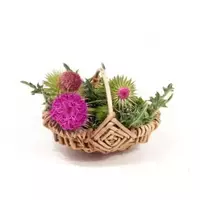Spotted thistle (thistle)

Thistle is spotted or, as the thistle plant is popularly called, belongs to the Astrovy family. Domestic gardeners often call thistle nothing more than a plant "sharp-variegated. " This is due to the distinctive appearance of the spotted thistle. Thistle is an annual plant with a height of no more than
1. 5 meters. Thistle leaves (thistle) are distinguished by the presence of thorns along the edge. Thistle blooms in the summer with large inflorescences of bright purple or saturated raspberry, smoothly turning into burgundy colors.
Scientists believe that the Mediterranean region can be considered the birthplace of holy thistle. According to researchers, the first to use milk thistle in cooking, as well as as a means of traditional medicine, residents of countries such as Italy, France, Greece, as well as Israel, Egypt and Turkey. Currently, spotted thistle is found in many regions of the world. Domestic gardeners rank thistle among aggressive weeds, which are quite difficult to fight.
Composition of thistle (thistle)
Perhaps the weedy status of the plant is just one side of the coin, since there is a clear and scientifically proven benefit of thistle (thistle) for the human body. If you pay closer attention to the chemical composition of thistle (thistle), then the benefits of the plant for the human body will become obvious. We think that our ancestors did not accidentally use the useful distinctive properties of thistle (thistle) as a healing agent for many centuries.
Until now, in folk medicine, and in addition, in the pharmacological production of medicines, various components of the plant are used spotted thistle. However, the most popular vegetable oil is obtained from holy thistle seeds. The chemical composition of thistle (thistle) contains about 25% fatty oil, and in addition, a sufficient amount of other substances and compounds useful for the human body.
The benefits of thistle (thistle)
The main benefit of thistle (thistle) is the chemical composition of the plant, which contains proteins of natural origin, as well as vitamin K and other macro- and trace elements. It is noteworthy that thistle is classified as honey plants. By collecting nectar, and in addition, bee thistle flower pollen process natural material into honey, as well as propolis or perga, thistle is used not only in folk, but also in official medicine for the manufacture of medicines, which helps to remove bile from the human body.
Such distinctive properties of thistle (thistle) are associated with the fact that the plant has a hepatoprotective effect. For the manufacture of both healing infusions and medical preparations, mature fruits-holy thistle fruits are used. Typically, holy thistle seeds are used in the treatment of certain liver and spleen diseases. The beneficial effect of holy thistle in hepatitis, jaundice, toxic liver lesions has been scientifically proven.
Thistle harm (thistle)
However, with all the advantages of the plant, in addition to benefits, there is also harm from spotted thistle (thistle), which can occur in case of individual intolerance. In addition, thistle (thistle) and derived medicinal products produced on the basis of the plant can be harmed in the presence of the following diseases: appendicitis, pancreatitis, calculous cholecystitis, hepatic colic, as well as in reflux disease.
spotted thistle (thistle) 396 kCal
The energy value of spotted thistle (thistle) (Ratio of proteins, fats, carbohydrates - ju):
Proteins: 24 g (~ 96 kCal)
Fats: 10g (~ 90kCal)
Carbohydrates: 52.5g (~ 210 kCal)
Energy ratio (bj | y): 24% | 23% | 53%
 Español
Español Français
Français Português
Português Русский
Русский 简体中文
简体中文 繁體中文
繁體中文 日本語
日本語 한국어
한국어 العربية
العربية Türkçe
Türkçe Қазақ
Қазақ Deutsch
Deutsch Italiano
Italiano Українська
Українська
